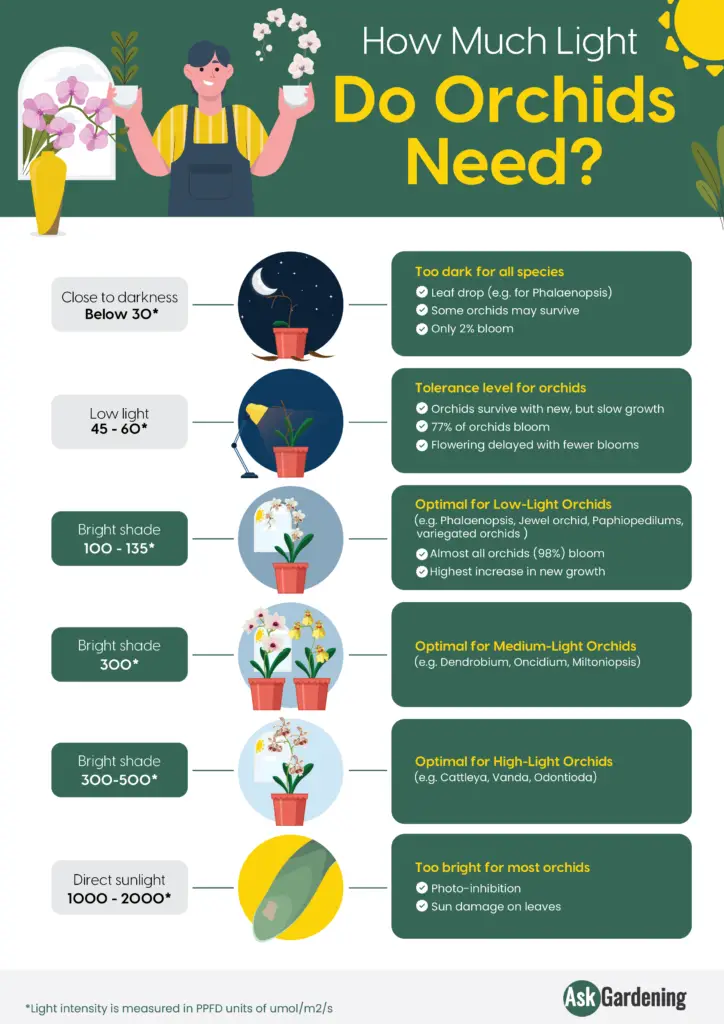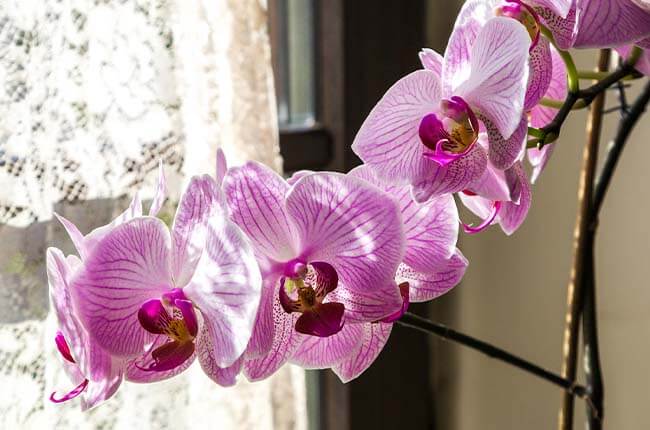Orchids are shade-loving plants but they can suffer from too little and also too much light.
How much light is the best for orchids?
The optimal light intensity for low-light orchids (e.g. Phalaenopsis, Jewel Orchids) is 100 μmol/s/m2 and that for high-light orchids (e.g. Cattleya, Vanda) is 500 μmol/s/m2, and for a photoperiod of 12-14 hours for healthy growth and flowering. This would translate to a bright shade by an east-facing or a south-facing window.
In this article, we will explain how to best measure light intensity using a light meter, what the measurement units mean, and the optimal range for different types of orchids which are helpful in selecting the best grow light for orchids.
Be sure to save this post for our light requirement chart.
Orchid Light Requirement Chart

1. Can Orchids Live In Low Light?
Orchids are adapted to low light conditions as they are adapted to living under the canopy of trees in rainforests. But, this does not mean that orchids can thrive in darkness. With too little light, the health of orchids will suffer and they will have problems with spiking and flowering.
According to a study (Konow & Wang 2001), low light intensity (i.e. below 100 umol/s/m2, or 2.6% of full sunlight) resulted in:
- slow growth of orchid seedlings in-vitro, with smaller plants and longer production time
- shorter, narrower, fewer and thinner leaves, and smaller total leaf area and fewer roots
- lack of blooming (only 2% of the orchids bloomed in low-light situations). Orchids under a higher light intensity (100 – 120 umol/m2/s) performed slightly better but produced only half the quantity of flowers which were smaller in size than orchids under a higher light intensity (200 – 280 umol/m2/s). An increase in light intensity helps blooming because light helps the photosynthetic production of sugar. And a continuous supply of sugar to the apex of a reproductive bud is essential for floral development.
- and even leaf drop under very low light conditions below 50 umol/m2/s after 6 weeks (Wang, 1995; Kubota & Yoneda, 1993).
Related: How adjusting light intensity and temperature can trigger blooming in orchids
2. Can Orchids Get Too Much Light?
Exposing orchids to too much light not only would result in sunburnt leaves, but more importantly stunted growth as it would affect photosynthesis by inhibiting the opening of stomata on the undersides of leaves, which are responsible for the intake of carbon dioxide.
(But many orchid species can be trained to acclimatize to very strong light, even the full sun, and would even thrive under very strong light)
Orchids are supposed to open their stomata during night time and during the early morning hours which are supposed to only close when it gets bright and hot in the day. (Click here to learn more about stomata opening in orchids).
According to a study of Dendrobium orchids, a light intensity of PPFD 1000 umol/m2/s and above inhibited the aperture of stomata during nighttime and allowed for a full opening only for a short period of time after dawn (Su & Zhang, 2003).
Cattleyas can tolerate a higher light intensity and will only suffer from photo-inhibition with an intensity of 1650 umol/m2/s or above (Stancato, Mazzafera & Buckeridge, 2002).
Related: Why “umol/m2/s” (PPFD) is The Best Metric to Measure Light Intensity for Growing Plants
3. Orchids’ Light Intensity Requirement
The optimal light intensity for all types of orchids is 100-500 umol/m2/s. This level of lighting promotes photosynthetic activities as it allows the leaf stomata to open fully during the whole night (i.e. a longer period of time) for the intake of carbon dioxide.
Some orchid species such as Phalaenopsis, Jewel orchids can tolerate low light, as low as 46 umol/m2/s. However, their optimal light for development and blooming is 100 umol/m2/s. This is based on the experiment findings by Konow & Wang (2001).
The experiment was done over a year at a greenhouse using a shade cloth to keep only 12% (for high light PPFD), 5.4% (medium light PPFD) and 2.6% (low light PPFD) of the sunlight (which is ranging from 1700 to 2300 umol/m2/s from summer to winter).
High PPFD resulted in the highest increase in fresh weight of roots and leaves, earlier flowering, more and bigger blooms than medium or low PPF. Nearly all (98%) of the orchids under the high light treatment produced flowers. Medium-light intensity does not produce as good results as high-light intensity but it can still result in an increase in plant growth (fresh weight), and 77% of orchids bloom. I call this the tolerance range where orchids can still survive but not thrive. However, low light intensity produced very little increase in fresh weight and almost no orchids (only 2%) could bloom.
And so, how much artificial light should we give to Phalaenopsis according to the experiment results?
Since most artificial lights do not have fancy dimmers to replicate the path of the sun and can only be turned “on” or “off”, providing a constant brightness throughout the day, artificial lights need to provide a constant light at a lower intensity to prevent overdosing plants on the light. In such a situation, according to Kelly McCracken from High Dessert Orchids , it has been found that plants need about 30-50% less than the light target estimates.
In the experiment, the high PPFD given after being filtered by the shade cloth was 204 – 276 umol/m2/s. A 50% discount of that would be roughly 100 – 135 umol/m2/s. This can be taken as the optimal intensity of artificial light for Phalaenopsis, variegated orchids, and other low-light orchids.
The medium PPFD given after being filtered by the shade cloth was 92 – 124 umol/m2/s. A 50% discount of that would be roughly 45 – 60 umol/m2/s. This can be taken as the tolerance limit for Phals where they can survive but would not thrive with big, numerous blooms.
The low PPFD given in the experiment was 44 – 60 umol/m2/s. A 50% discount of that would be roughly 22 – 30 umol/m2/s. This level can be regarded as too low for even Phals and low-light orchids as they would hardly bloom and produce very little vegetative growth.
Apart from Phalaenopsis, another study shows that Dendrobiums perform well at moderate light (300 umol/m2/s).
Vandas and Cattleyas are considered high-light orchids as they require a higher light intensity (300 – 500 umol/m2/s) to grow.
The following chart shows the low and high light requirements of different orchid genera, based on the findings gathered and cross-checked from various scientific studies (Guo, Lin & Lee, 2012; Wang, 1995; Kubota & Yoneda, 1993; Kubota et al., 2005; Stancato, Mazzafera & Buckeridge, 2002)
Light Intensity (PPFD in umol/m2/s) | Impact on Orchid Growth |
Below 30 Close to darkness | Too dark for all species
|
45 – 60 Low light | Tolerance level for orchids
|
100 – 135 Bright shade | Optimal for Low-Light Orchids (e.g. Phalaenopsis, Jewel orchid, Paphiopedilums, variegated orchids )
|
300 Bright shade | Optimal for Medium-Light Orchids (e.g. Dendrobium, Oncidium, Miltoniopsis) |
300 – 500 Bright shade | Optimal for High-Light Orchids (e.g. Cattleya, Vanda, Odontioda) |
1000 – 2000 Direct sunlight | Too bright for most orchids
|
What does the optimal light intensity of 100 and 500 umol/m2/s mean? This is basically a bright shade, the same intensity of a direct sunshine in the early morning hours or late summer afternoon before sunset. The best indoor position for growing orchids (in northern hemisphere) is by an east- or west-facing window sill or by a south-facing window with filtered sunlight or being placed away from the window.
4. Orchids’ Light Duration Requirement
Orchids require at least 12-13 hours of light per day in winter and 14-16 hours in spring, summer and fall. Plants do better with less light over a longer duration than with stronger light over a short duration.
But they do need darkness. Leaving them under artificial light the whole day would inhibit their growth as their stomata open in darkness for gas exchange.
5. How To Tell If An Orchid Has Too Little Or Too Much Light?
The simplest way of checking light intensity is to check the response from the foliage: too much light would result in discolored, pale leaves, also known as “sunburn”, while too little light would result in dark green leaves. But the problem with this method is that the damage can remain for months, even years. And, the method is not efficient because orchids being slow-growing plants take a long time to see the environmental effects on their growth.
The most accurate way to measure light intensity is by using a professional light meter. In units of Photosynthetic Photon Plux Density (PPFD). This article explains all you need to know about PPFD and why it is better than units of Lux, Lumen, foot candles. You could also use your cell phone and apps such as Photone – Grow Light Meter (for iPhone and iPad) or PPFD Meter by Home Studio Inc. (for android devices).
Conclusion
Too little light prevents orchids from healthy growth and affects flowering. But too much light can cause sunburn, and more importantly inhibit photosynthetic activities.
Although low-light orchids (e.g. Phalaenopsis) can tolerate light intensity as low as 45 μmol/s/m2, the optimal lighting intensity for low-light orchids and high-light orchids (e.g. Vandas and Cattleyas) is between 100 and 500 μmol/m2/s respectively, which is a bright shade or filtered light by the window.
Knowing the specific range of light intensity required by orchids can also help us choose the right grow light for orchids and optimize the amount of light the plant gets per watt of electricity.
Happy gardening!
Related
Top 8 PAR Light Meters For Orchids (2023)
Best Grow Light For Orchids: Buying Tips & Setting Up
References
Su W, Zhang G (2003). [Primary study on photosynthetic characteristics of Dendrobium nobile]. Zhong Yao Cai, 26(3) 157-159.
Konow, E. & Wang, Y.T. (2001). Irradiance Levels Affect in vitro and Greenhouse Growth, Flowering, and Photosynthetic Behavior of A Hybrid Phalaenopsis Orchid. Journal of the American Society for Horticultural Science, 126(5):531–536.
Ueda , H. and H. Torikata. (1972). Effects of light and culture medium on adventitious root formation of Cymbidiums in aseptic culture. Amer. Orchid Soc. Bul. 41:323–327.
Chen, W.-S., H.-Y. Liu, Z.-H. Liu, L. Yang., and W.-H. Chen. (1994). Gibberellin and temperature influence carbohydrate content and flowering in Phalaenopsis. Physiol. Plant. 90:391–395.
Kubota, S. and K. Yoneda. (1993). Effects of light on development and nutritional status of Phalaenopsis. J. Jpn. Soc. Hort. Sci. 6(1):173–179.
Kubota, S., Yamamoto, J., Takazawa, Y., Sakasai, H., Watanabe, K. Yoneda, K., and Matsui, N. (2005). Effects of Light Intensity and Temperature on Growth, Flowering, and Single-leaf CO2 Assimilation in Odontioda Orchid. Journal of the Japanese Society for Horticultural Science, 74 (4), pp. 330-336.
Stancato, G., Mazzafera, P. & Buckeridge, M. (2002). Effects of light stress on the growth of the epiphytic orchid Cattleya forbesii Lindl. X Laelia tenebrosa Rolfe. Brazilian Journal of Botany, 25(2), June.
Wang, Y.T. (1995). Phalaenopsis Orchid Light Requirement during the Induction of Spiking. HortScience, 30(1): 59-61.
- Top 6 Drip Irrigation Systems for Raised Beds (2025) - January 31, 2025
- Top 10 Orchid Fertilizers: A Comprehensive Review (2025) - January 16, 2025
- Top 6 Slow-Release Fertilizers for Houseplants & Veggies (2025) - January 15, 2025

